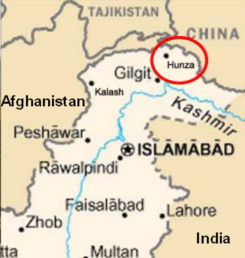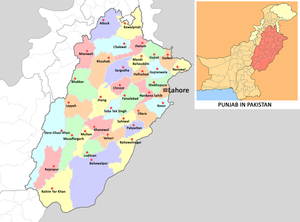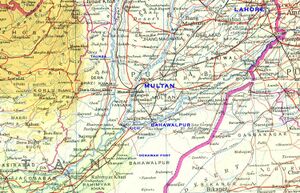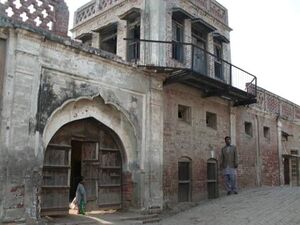Faisalabad
| Author:Laxman Burdak, IFS (R) |
Faisalabad (Hindi:फैजलाबाद, Punjabi:ਫੈਜਲਾਬਾਦ, Urdu: فیصل آباد) is a city in the Punjab province, Pakistan. It was formerly known as Lyallpur , named after the founder of the city, but was renamed in 1977 in honour of late King Faisal of Saudi Arabia.
Variants
Etymology
Faisalabad, formerly (until 1977) Lyallpur, is a city in the east-central Punjab province of Pakistan, in the Rechna Doab upland. When founded in 1890, it was named for Sir James Broadwood Lyall, lieutenant governor of the Punjab.[1][2] It became headquarters of the Lower Chenab colony and in 1898 was incorporated as a municipality.[3]
In September 1977, the city of Lyallpur was renamed "Faisalabad" by the Government of Pakistan in honor of King Faisal of Saudi Arabia who had a great love for Pakistan and its people.[4]
Tahsils in the District
Jat clans in Faisalabad District
According to 1911 census, the following were the principal Muslim Jat clans in Faisalabad District[5]:
Ahir (580), Atwal (1,849), Aulakh (876), Awan (2,085), Bains or Waince (2,635), Bajwa (3,868), Bar (1,084), Bandech (725), Bhatti (9,190), Chadhar (3,428), Chahal (444), Chhaj (510), Changar (843), Chatha (967), Cheema (629), Chhina (202), Chauhan (629), Dhillon (1,147), Dhariwal (596), Deo (610), Ghuman (1,022), Gill (3,865), Gondal (997), Goraya (2,158), Hundal (495), Haral (1,312), Hanjra (805), Janjua (509), Jauson (531), Johal (56), Johiya (1,371), Kahlon (3,037), Kaliar (312), Kamoka (943), Kalasan (581), Kharal (4,985), Khera (326), Khichi (2,219), Khinge (506), Khokhar (3,371), Lak (679), Lona (1,051), Lurka (2,288), Maan (437), Nonari (858), Pansota (1,941), Rajoke (981), Randhawa (2,335), Sahi (805), Sial (5,464), Sidhu (224), Sandhu (3,659), Sipra (1,943), Tarar (514), Vahniwal (782), Virk (1,005), Wahla (1,215), Waraich (3,443), Waseer (1,661), Wasli (67), Wattu (1,695),
History
The very first name of Faisalabad was Chenab Colony, then Sandalbar, then Lyallpur and currently is Faisalabad. Faisalabad was once part of ancient district of Jhang and Sandalbar, a 50 square kilometres part mainly consisted of thick forests and wild tribes. The tract from Shahdara to Shorkot, Sangla Hill to Toba Tek Singh, was traditionally called Sandalbar.
In 1880, a colonial officer called Captain Poham Young proposed a new town, with a design based on the Union Jack, with eight roads radiating from a large clock tower in the centre. The eight roads developed into eight separate bazaars. The construction of artificial canals allowed the surrounding areas to be irrigated. The town grew rapidly as people were invited with promises of land.
जाटों का विस्तार
डॉ रणजीतसिंह[6] भारत भूमि में जाटों के विस्तार को देखते हुए योगेन्द्रपाल शास्त्री [7] ने लिखा है कि ...."जाट अपने आदि देश भारतवर्ष के कोने-कोने में नहीं वरन उपजाऊ प्रदेशों की ऊंची भूमियों पर बसे हुए हैं। नदियों की अति निकटवर्ती खादर भूमि या पहाड़ों की तलहटी में उनकी सामूहिक विद्यमानता नहीं पाई जाती। डेरा गाजी खां, डेरा इस्माइल खां, डेरा फतेह खाँ, बन्नू, कोहाट, हजारा, नौशेरा, सियालकोट, गुजरात, गुजरान वाला, लायलपुर, मिंटगुमरी, लाहौर की चुनिया तहसील में कुल मिलाकर 25 लाख जाट आज भी बसे हुए हैं। यद्यपि इनका धर्म है इस्लाम है किंतु रक्त की दृष्टि से जाट होने का उन्हें गर्व है। विभाजित भारत में जाटों की संख्या किसी भी प्रकार कम नहीं है। "
Notable persons
External links
Gallery
Sardar Ishri Singh Mohil (pic of circa 1868) Estate of Layallpur, Punjab (present Pakistan). He was born into Hindu Mohil Jat family. Sardar Ishri Singh's father Name was Sardar Dhanna Singh of Layallpur. Estate:- Dabra Hisar, Dynasty:- Mohil, Source - Jat Kshatriya Culture
References
- ↑ Talbot, Ian (2020). The History of British Diplomacy in Pakistan. Routledge. p. 275.
- ↑ Puri, Kavita (2019). Partition Voices. Bloomsbury. p. 108.
- ↑ Britannica "Faisalabad". Britannica.
- ↑ The Express Tribune "From Lyallpur to Faisalabad: the city of eight bazaars". The Express Tribune. 24 January 2022.
- ↑ Census Of India 1911 Volume xiv Punjab Part 2 by Pandit Narikishan Kaul
- ↑ Jat Itihas By Dr Ranjit Singh/1.Jaton Ka Vistar,p. 6
- ↑ योगेद्रपाल, क्षत्रिय जातियों का उत्थान और पतन, पृष्ठ 271-73
Back to Pakistan




